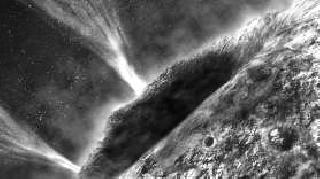
An artistic illustration of the Wild-2 comet. A NASA photo
TUCSON, USA (BNS): A comet may not just be a ‘dirty snowball’ anymore and could harbour pockets of liquid water as well.
Scientists for the first time have traced minerals that require water for their formation from dust particles collected from a distant comet.
The discovery defies the current paradigm that comets never get warm enough to melt the ice that makes up the bulk of their material.
The study, led by University of Arizona graduate student Eve Berger and colleagues, looked into samples collected by NASA’s Stardust comet hunter from the Wild-2 comet way back in 2004.
Launched in 1999, the Stardust spacecraft scooped up tiny particles released from the comet’s surface in 2004 and brought them back to Earth in a capsule two years later.
“Current thinking suggests that it is impossible to form liquid water inside of a comet,” said Dante Lauretta, part of the University of Arizona team of researchers.
“In our samples, we found minerals that formed in the presence of liquid water,” said Eve Berger, adding that at some point in its history, the comet must have harboured pockets of water.
Comets are frequently called “dirty snowballs” because they consist of mostly water ice, peppered with rocky debris and frozen gases. Comets also sport a tail made up of gas and vapour.
“When the ice melted on Wild-2, the resulting warm water dissolved minerals that were present at the time and precipitated the iron and copper sulfide minerals we observed in our study,” Lauretta said.
“The sulfide minerals formed between 50 and 200 degrees Celsius, much warmer than the sub-zero temperatures predicted for the interior of a comet,” the researcher said.
The 3.4 mile-wide Wild-2 comet, discovered in 1978 by Swiss astronomer Paul Wild, is estimated to be 4.5 billion years old. It is believed to be originated in the Kuiper belt – a region extending from beyond Neptune’s orbit into deep space, containing icy debris left over from the formation of the Solar System.
Wild-2 is thought to have spent most of its time in the Kuiper belt, transiting on unstable orbits within the planetary system before Jupiter’s gravity hurled it into the neighbourhood of the Sun. A close encounter with the giant planet’s field of gravity placed the comet in a new, highly elliptical orbit and brought it closer to Sun.
The discovered minerals from the comet’s dust grains also put an upper limit to the temperatures Wild-2 encountered during its origin and history, the scientists said. A mineral, called cubanite, spotted in the samples is found in temperatures below 210 degrees Celsius.
“Wherever the cubanite formed, it stayed cool,” Berger said. “If this mineral formed on the comet, it has implications for heat sources on comets in general.”
The latest discovery with the interesting details will help scientists in further understanding comets, their origin and history.
“What we found makes us look at comets in a different way,” Lauretta said, adding, “we think they should be viewed as individual entities with their own unique geologic history.”
 Previous Article
Previous Article Next Article
Next Article












The Indian Air Force, in its flight trials evaluation report submitted before the Defence Ministry l..
view articleAn insight into the Medium Multi-Role Combat Aircraft competition...
view articleSky enthusiasts can now spot the International Space Station (ISS) commanded by Indian-American astr..
view article